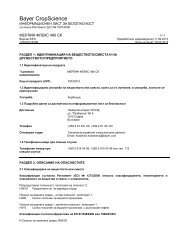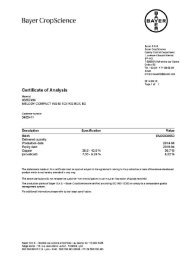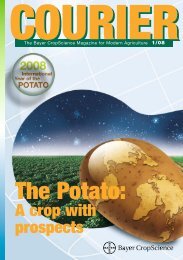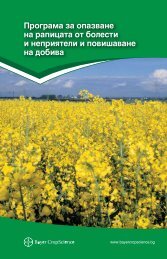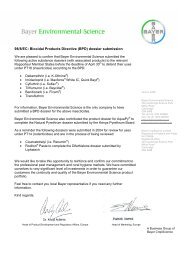For healthy potatoes - Bayer CropScience
For healthy potatoes - Bayer CropScience
For healthy potatoes - Bayer CropScience
You also want an ePaper? Increase the reach of your titles
YUMPU automatically turns print PDFs into web optimized ePapers that Google loves.
Life cycle of<br />
Phytophthora infestans<br />
Sporulation<br />
Mycelia of two<br />
mating types meet<br />
Sporangia<br />
dispersal<br />
Direct Germination<br />
(High temperature)<br />
Oospore<br />
formation<br />
Sexual<br />
Reproduction<br />
Mycelial growth<br />
in leaves & tubers<br />
Sporangial<br />
germination<br />
Zoospore<br />
formation<br />
Oospore<br />
germination<br />
Indirect Germination<br />
(Low temperature)<br />
Sporangial<br />
germination<br />
Cyst<br />
germination<br />
Zoospore<br />
mobility<br />
Population studies<br />
Zoospore<br />
encystment<br />
The late blight pathogen Phytophthora<br />
infestans originated in the central highlands<br />
of Mexico. The spread of the<br />
pathogen to the rest of the world occurred<br />
in two major waves of migration. The first<br />
migration occurred about 160 years ago.<br />
The fungus was inadvertently transported<br />
across the Atlantic on ships, after which it<br />
established itself quite rapidly throughout<br />
Europe, Asia and Africa. <strong>For</strong> a long time,<br />
populations in Central Europe remained<br />
very uniform: only mating type A1 was<br />
present in Europe and Asia. Any adaptive<br />
changes by the pathogen that occurred<br />
would have been through mutation or<br />
mitotic crossing-over. Exchange of genes<br />
through sexual recombination would not<br />
have been possible, because only one mating<br />
type (A1) was present (sexual recombination<br />
depends on two mating-types {A1<br />
und A2} being present). This remained the<br />
situation until about 1975.<br />
The pathogen’s second great wave of<br />
migration occurred in the mid-nineteenseventies.<br />
In 1976 and 1977, large numbers<br />
of Mexican ware <strong>potatoes</strong> were imported<br />
into Europe: among them were tubers with<br />
latent infections, including new (to Europe)<br />
2/06 COURIER 13






